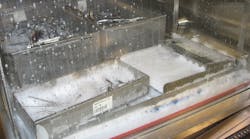Water quality and hardness: to spot, or not to spot?
Q
“We have what I call a ‘white film’ on the inside of our washer. What are your thoughts?”
A
I have seen inside washer disinfectors (WD) in many departments (Figure 1) that fit the description in your question. Before we get into my response, I first want to pose four important questions of concern:
- Do you have a process for descaling your washer?
- How often are you checking your water quality?
- What type of final rinses are you using in your WD?
- What is your cleaning solution dilution set at?
As you can see, the causes could be one, or a combination of factors on why you have this “white film," or “scum,” as I say.
First, a sterile-processing department (SPD) usually has and uses two types of water as defined by Advancement of Medical Instrumentation (AAMI) TIR30—Utility (used in all stages of cleaning, except the final rinse) and Critical (for the final rinse).1
Let’s first investigate water hardness to address this concern. Water hardness is the concentration of calcium and magnesium ions expressed in terms of calcium carbonate (CaCO3). Hard water might leave a white/gray-colored residue on all types of surfaces like the walls of your washer. This might also shorten the life span of your medical instrumentation.2,3
Next is concentration of your cleaning agent(s). You did not mention foaming inside your washer, but if you have foaming, you also are having possible cleaning-agent dilution issues. This could also add to the “white film” or “scum” you are seeing. Remember, a basic rule with cleaning agents is that they are typically low-foaming. If you have foaming, it could be another cause of the “white film” or “scum” on the WD chamber walls.
Let us explore how water hardness affects the cleaning action of your chosen cleaning agent.
Cleaning agents can lose effectiveness when used in hard water (hardness). Hardness in water is mostly caused by the presence of the mineral salts calcium (Ca) and magnesium (Mg). Iron (Fe) and manganese (Mn) can also be culprits.
Ever turned on a faucet and “yuck” came out? Remember, often the water that comes out of your sink faucet is the same water going into your WD. Water quality can change even within a facility’s delivery system. This could be because of the condition of pipes, construction taking place in other parts of the facility, and other factors. SPD should monitor the quality of water periodically. Water that originally enters the facility could travel a long path amid diverse types of piping, and by the time it reaches your department the quality of water can change.
Because water quality plays such a significant role in the proper operation of a modern hospital, the physical plant departments of most healthcare facilities test the water quality at least daily. In fact, many do so on an hourly or even on a constant real-time basis. This information is available, and sterile processing departments should request a copy of these results.
It is this author’s opinion, based on years of observation, that if you see something on the walls of your WD it will eventually appear on your medical devices. The WD is not using the proper final rinse (Critical Water), and not properly drying the medical devices once completing the last stage.
One article makes the following statements on why water spots might appear after the items come out of a WD. The article states that, “even though the parts appear ‘dry and visually clean,’ [you still] find spots are from water,” left on the device. “If even a few drops of rinse water are left on the parts, then when water evaporates, it concentrates the trace salts and leaves calcium, magnesium, and iron deposits. These often appear in characteristic sets of white ring shapes, i.e., water spots. This often happens because of a less than optimal blowing [/drying] process after rinsing.”4
Next are the instructions for use (IFU) of the medical device. Most WD companies recommend the use of Critical Water as the final rinse. This rinse helps remove any residual detergent that could be left on the medical device before the drying process. Depending on the type of system you use to produce Critical Water final rinse, you need to monitor that system. I have been in departments that have great systems; however, they do not monitor, and their systems do not work properly.
Some WD(s) have a cycle specifically used for descaling the equipment. Depending on your model, it could be weekly, monthly, or used as needed.5,6,7 The frequency of descaling might be a warning sign of water quality issues.
Last, read the operators manual for your WD and the cleaning agent’s IFU. These will help in making sure you are using the right dilution and water quality.
As you can see, finding the source producing this “white film" or "scum” is not simple. It requires critical thinking and involving many partners to resolve this issue. I hope I have given you a road map to start solving your challenge.
References
1. AAMI. (2019). ANSI/AAMI ST108:2019 Water for the processing of reusable medical device [intended to replace the technical information report (TIR) AAMI TIR34:2014/(R)2017, Water for the reprocessing of medical devices]. Association for the Advancement of Medical Instrumentation (AAMI).
2. Basile, R. and Kovach, S. (January 2003). Thorough Cleaning: Critical Aspects of the Cleaning Process, Part Two: Water: Qualities vs. Quality, Managing Infection Control. Central Sterile Management, 62-65.
3. Kovach S.M. (January 2008). The Cause and effect of instrument staining. Materials Management in Healthcare, 38-39.
4. Alconox Inc. (December 19, 2017). Water Spots on Stainless? Improve Blowing Process. TechNotes.Alconox.com. http://technotes.alconox.com/detergents/alconox/water-spots-on-stainless-steel/.
5. STERIS Corporation. (June 27, 2003). MAINTENANCE MANUAL RELIANCE® SYNERGY™ WASHER/DISINFECTOR (P764330-664), 22,121,123. http://www.frankshospitalworkshop.com/equipment/documents/various_equipment/service_manuals/washer_disinfector/Steris%20Reliance%20Synergy%20Washer%20Disinfector%20-%20Service%20manual.pdf.
6. STERIS Corporation. (September 4, 2014). OPERATOR MANUAL Reliance® 400XLS Laboratory Glassware Washer; Reliance® S00XLS Laboratory Glassware Washer (P920514-444), 22,25,51,63,64,73,77. PDF found at: https://www.sterislifesciences.com//-/media/files/lifesciences_com/pdf/washing/reliance-400xls-500xls-washers/reliance-400xls-500xls-laboratory-glassware-washers-technical-data-sheet.ashx.
7. GETINGE DISINFECTION. (n.d.). USER MANUAL Washer disinfector 46-2,46-4,46-5; Mfg. no. SEV0440130-5018610-00, 13,16. PDF found at: http://www.frankshospitalworkshop.com/equipment/documents/various_equipment/user_manuals/washer_disinfector/Getinge%2046-x%20Washer%20disinfector%20-%20User%20manual.pdf.
About the Author

Stephen M. Kovach
Stephen M Kovach, BS, CFER, started in the medical field in 1975 as a sterilization orderly and has worked in many positions within the Healthcare Industry. He presently is Clinical Educator Emeritus at Healthmark, A Getinge company.

